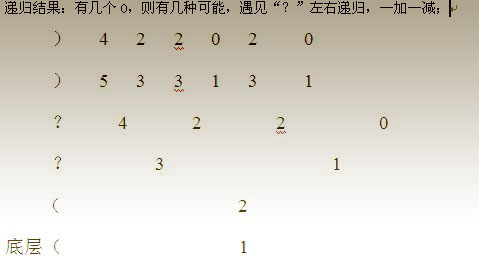Problem Description
给出一个字符串,其中包括3种字符: ‘(‘, ‘)’, ‘?’.其中?表示这个字符可以是’(‘也可以是’)’. 现在给出字符串S,你可以在’?’处填写’(‘ 或者 ‘)’,当然随意填写得到的序列可能是括号不匹配的。例如”(?”,如果你填写’(‘那么”((“是括号不匹配的! 现在你的任务是确定你有多少种填写方案,使得最终的字符串是括号匹配的!2种方案是不同的,当2种方案中至少存在1个填写字符是不同的。 例如,对于”((??))”,我们可以得到2种方案: “((()))”, “(()())”。
 Input
Input
数据包含多组测试数据第一行输入一个字符串S(S的长度不超过16)。
 Output
Output
输出一个整数,表示合法的填写方案数。
 Sample Input
Sample Input
((??))
 Sample Output
Sample Output
2
讲解:刚开始看这个题,你会想到括号配对,但是呢这两个题却又不太一样,所以我们依然也可以采用那种方式来做的,只不过要变换一次递归一次,最后递归出来结果,下面就以例题为例子讲解一下:
注意:遇见0了则不能再进性下去;
如图所示:

1 #include<iostream> 2 #include<cstdio> 3 #include<cstring> 4 using namespace std; 5 char str[1010]; 6 int len; 7 int ans; 8 void fun(int end,int k) 9 { 10 if(end==len && k==0) 11 { 12 ans++; 13 } 14 if(k<0) 15 { 16 17 } 18 else if(str[end]=='?') 19 { 20 fun(end+1,k-1); 21 fun(end+1,k+1); 22 } 23 else if(str[end]=='(') 24 { 25 fun(end+1,k+1); 26 } 27 else if(str[end]==')') 28 { 29 fun(end+1,k-1); 30 } 31 } 32 int main() 33 { 34 while(gets(str)) 35 { 36 ans=0; 37 len=strlen(str); 38 fun(0,0); 39 printf("%d\n",ans); 40 } 41 return 0; 42 }



![[转贴]犯贱报(一张浓缩大学生活的..)](http://pic.xiahunao.cn/[转贴]犯贱报(一张浓缩大学生活的..))











)



